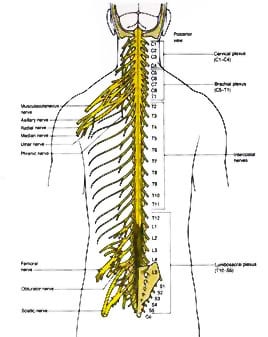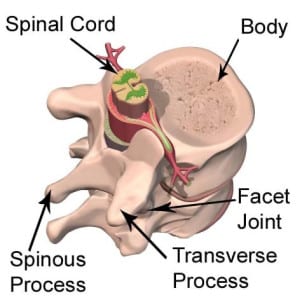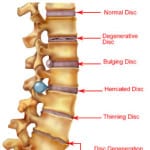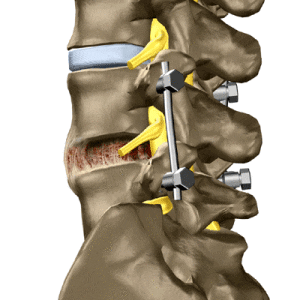Low Back Pain
With persistent lower back ache shooting pains down the legs can occur. Muscles can get so tight that if affects your ability to stand straight. When back pain gets this severe frequently the problem is that the muscles are in spasm due to a nerve root irritation near the spine.
The solution depends on why the nerve got irritated in the first place. If it occurred secondary to a weak ligament (just like a sprained ankle) then addressing the underlying source is often necessary to stop it from reoccurring. Some people think that if there is nerve root irritation (sciatica) then the resulting back pain must be severe but depending upon the degree of involvement this is not necessarily true. If the nerve is involved however the key for initial treatment is to relieve the nerve irritation. As a result, it is worth checking for nerve irritation even mild episodes of persistent low back pain.

The spinal column is an intricate network of ligament, nerve, vasculature, disc and bone. The spinal cord rests inside of the spinal column. Motor nerves lead out of the spinal cord while sensory nerves enter into the spinal cord. Together, the motor and sensory nerves form more nerve roots, which run through holes, called foramina, in the bones of the spinal column. Each one of these nerve roots has the potential to become irritated and cause back pain. A special third nerve type referred to as the sympathetic nerve travels alongside the spinal column. This nerve transmits burning, weather sensitive pain signals.

Spinal disks are jelly donut like structures that act like a shock absorber to both protect the spinal cord by separating each of the bones, or vertebra, in the spine and to reduce pressure on the bones themselves. If any of the jelly comes out of the disc, or if the disk bulges and presses on a nerve root, irritation may occur and back pain can result. In more severe cases leg pain may also occur.


There also can be limb weakness, numbness, and reflex changes if a nerve root in the lumbar spine is irritated. If there is loss of bowel or bladder control then a surgical emergency exists.
If low back pain occurs with a fever or persists after injury or accident then it is always a good idea to have a physician evaluate the condition.
In most cases of low back pain conservative treatment at home for two or three days will be effective. Anti-inflammatory medications like ibuprofen or aspirin can reduce irritation. Avoiding strenuous for a few days can also help but bed rest alone has been shown not to be beneficial.
If the low back pain gets worse or does not improve the next step is to see a physician. If this is your first episode of low back pain then the primary care physician is usually qualified to help you through. If first line treatment options do not provide relief within two weeks, it may be time to consider other options. If symptoms persist beyond four to six weeks a specialist may be needed.
For patients with a history of back pain and who are currently experiencing symptoms that are interfering with activities, the first step is a proper physical exam followed by diagnostic testing. Imaging studies, including CT scans and magnetic resonance imaging (MRI), help to determine if there is a surgically treatable problem, and the severity of that problem.
If consideration for surgery is not on the table then there is often no real good reason to start with advanced imaging studies. The physician must be able to correlate the patient’s symptoms with their imaging studies before considering a surgical procedure. It is also common for patients to have abnormal MRI findings, but no symptoms. Standard x-rays are useful to look for degenerative changes, fractures or signs of spinal instability.
Imaging studies aren’t the only factor in determining what treatment options are available. Test that look at physiology or function such as EMG may provide more relevant information. Diagnostic Ultrasound is diagnostic test that can evaluate for ligament damage without exposure to ionizing radiation.
There are many non-surgical choices for the treatment of low back pain. Options include physical therapy, weight loss, steroid injections, non-steroidal anti-inflammatory medications, rehabilitation and limited activity. Since 90 percent of cases get satisfactory relief without surgery in the absence of loss of bowel or bladder eight to twelve weeks of conservative therapy is often tired before surgery is considered.
If surgery is recommended several options are available. The most common procedure is a discectomy, which involves removing the soft gel-like material in the disc. This procedure is intended to return the disc to a more normal shape and relieve pressure off of nerve roots.
Surgeons sometimes also remove a small piece of bone in the vertebrae (part of the spinal column) in order to gain access to the spine or to provide more space around a nerve root. A foraminotomy is a procedure designed to expand the opening through which the nerve travels.
Surgery is often considered if Leg pain limits your normal activity, resulting in diminished quality of life, there is leg weakness or numbness, it is difficult to walk or stand or if physical therapy, medication or injections are ineffective.

If there is too much involvement to isolate the problem to one area surgeons are often hesitant to operate as his only alternatives might be to do a several disc replacements or to fuse the bones together with bone grafts and to stabilize the vertebra with instrumentation such as metal plates, screws, rods and cages. Both of these procedures can result in other problems later on since normal anatomy has been changed motion is distorted.
Fortunately, the majority of cases do not require surgical intervention. At Piedmont Physical Medicine & Rehabilitation, we work closely with you in order to help assure a favorable outcome irrespective of which method of treatment is pursued.
Ten common Myths of Low Back Pain
1) Rest helps: While it is generally a good idea not to overdo, there is no evidence that rest helps and there is good evidence that outcomes are better when activity is encouraged.
2) Degenerative Disk Disease: While degenerative disk disease does suggest wear and tear, it is present it virtually everyone beyond 35 years of age. Its mere presence does not in and of itself mean that it is the source of your pain.
3) Strengthening helps: Obtaining or maintaining a strong “core” does help prevent and treat low back pain, but before you strengthen what is weak you must reeducate what is inhibited and then stretch what is tight.
4) Numbness means I have a pinched nerve: Unless there is a true lack of sensation to pin prick, other structures such as muscle or ligament can make you feel as if you are numb and should not be confused for nerve.
5) Weather sensitive pain is an old wives tale: Weather sensitive pain is quite real. Its presence suggests that the sympathetic nerve (a special nerve type) is involved.
6) I need surgery since I have a herniated disc: The vast majority of people do not need surgery, even in the presence of a herniated disc. Unless there is loss of bowel or bladder control, or if progressive neurologic deficit is present, predicting outcomes with surgery is controversial.
7) I have an irritated nerve, so there must be something pressing on it: A nerve can be irritated due to inflammation, lack of oxygen, because it was stretched or if there are other medical conditions that do not let it heal. There does not have to be anything pressing on it for it to be irritated.
8) Bending is bad for your back: simply bending below the knee level in and of itself is nowhere as bad for your back and combining bending with twisting.
9) I’m feeling better now so my problem is resolved: It is quite possible to get relief from low back pain and still be an accident waiting to happen. An ounce of prevention is definitely worth a pound of cure when it comes to LBP.
10) As long as I take my medicine, I feel fine: Most often medicine can help you feel better, but that does not mean that you are better. You should still go out of your way to improve function and increase strength in order to help prevent reoccurrence.





